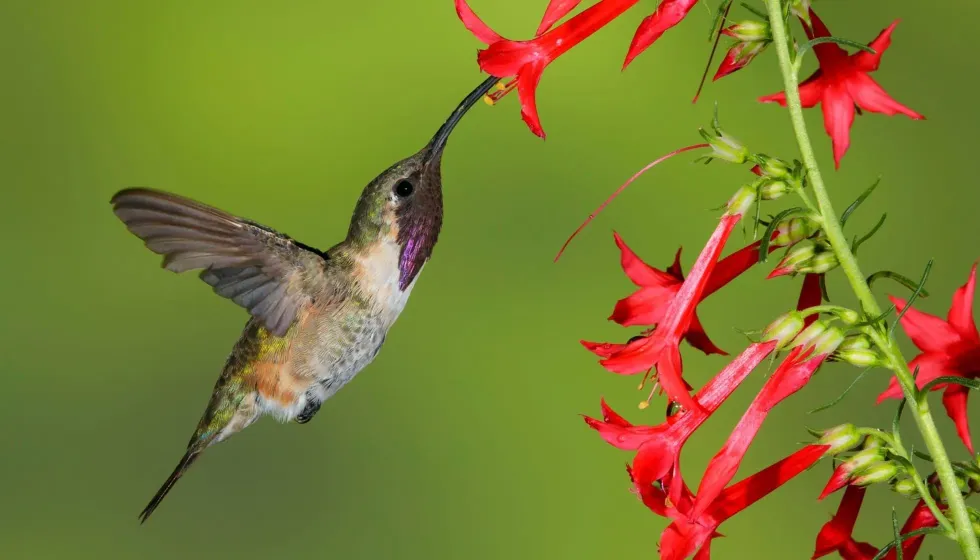The lucifer hummingbird (Calothorax lucifer) also, known as lucifer sheartail, is a medium-sized hummingbird species of the Trochilidae family. These birds are found in green, purple, and brown colors.
They have distinctly curved bill and outward flared gorget feathers. Lucifer in Latin translates to 'light-bearing,' which probably refers to the iridescent gorget of the male.
They are also called 'sheartail' due to their deeply forked tail. There are over 360 hummingbird species in this family.
Hummingbirds are native species of America. These birds are named so due to the humming sound created by their flapping wings at a frequency that is audible to a human ear.
This frequency is about 12 bps (beats per second) in big-sized hummingbirds to 80 bps in small ones. Compared to all the homeothermic species, these birds have the highest mass-specific metabolic rate.
Nicholas Aylward Vigors, an Irish zoologist, introduced the family Trochilidae with the genus Trochilus in 1825. A bird fossil found in 2013 in Wyoming showed that it was an ancestor of both swift birds and hummingbirds before they were separated into two different groups.
If you like reading this article, check out these Anna's hummingbird facts and calliope hummingbird facts.
Lucifer Hummingbird Interesting Facts
What type of animal is a lucifer hummingbird?
Lucifer hummingbird (Calothorax lucifer) is a medium-sized hummingbird species of the genus Calothorax and order Apodiformes. There is no social behavior between the adults and young ones. These birds can migrate from one place to another. These birds are aggressive nectar-feeders. This bird species is endothermic.
What class of animal does a lucifer hummingbird belong to?
Lucifer hummingbird (Calothorax lucifer) belongs to the class Aves of animals.
How many lucifer hummingbirds are there in the world?
The population of lucifer hummingbirds (Calothorax lucifer) is approximately 200,000.
Where does a lucifer hummingbird live?
The lucifer hummingbirds' range of locations is from central Mexico and northern Mexico. They also occupy a wide range in the south-western United States including West Texas, southeast Arizona, and southwest New Mexico. The Big Bend area in Texas is a reliable location to find these birds.
What is a lucifer hummingbird's habitat?
The habitat range of these North American birds varies according to their geographic locations. Their wide range of habitats include arid desert or dune, chaparral, and scrub forest regions.
They are found around deserts and arid regions with the agave plant. They also occupy foothills, plains, and sides of rocky hillsides throughout its range. They prefer a habitat altitude range between 3,500-5,500 ft (1,066-1,676 m) in dry washes that have desert shrubs and cacti, canyons and mountains.
Who do lucifer hummingbirds live with?
These North American birds are a solitary species. There is no social behavior between adults and young ones and they also do not form a group. The pairs do not form a bond during the breeding season.
How long does a lucifer hummingbird live?
The lifespan of a lucifer hummingbird recaptured in Texas was at least seven years.
How do they reproduce?
The breeding season is between April and August. These birds do not have a bond and are mostly polygamous. The male lucifer hummingbird displays a mating dance near the nest during courtship.
These displays take place during nesting and egglaying. The display involves the male flying over the female and then dive in with its forked tail or wing producing a snapping sound. Then it flies away with the forked tail feathers.
The male displays every hour for about 30-45 seconds. The female lucifer hummingbird builds her small cup-like nest on cacti or desert shrubs that are above 2-10 ft (0.61-3.05 m) from the ground. The female then lay white eggs, two per season.
The incubation period lasts for 15 days. The young leave the nest on the 23rd day. During the breeding season, females are observed to defend their nest from other hummingbirds and predators.
What is their conservation status?
The conservation status of these hummingbirds is of Least Concern. They are quite common and stable in their native areas. So, their conservation status is also good. Feeders are one of the reasons for their stable population. Their population is well maintained in the Big Bend National park by their feeders.
Lucifer Hummingbird Fun Facts
What do lucifer hummingbirds look like?

Lucifer hummingbirds are medium-sized and have a curved bill. They have small wings and deeply forked tail. They have a white streak behind their eyes. The colouration of the male lucifer hummingbird is different compared to a female.
Males have a green crown, iridescent plumage, dark forked tail, white underpants, and long magenta gorget. On the other hand, lucifer hummingbird female bird species are larger and have a pale throat, dull plumage, and buff or white underside with crimson trim. Females have no iridescence and are light brown-coloured.
How cute are they?
Hummingbirds are small and cute. So, they are considered cute animals.
How do they communicate?
This bird species communicates using the sense of touch, vocalization, visualization, and use of chemicals.
How big is a lucifer hummingbird?
The female bird species are larger than the male. They grow up to 3.9 in (10 cm)
How fast can a lucifer hummingbird fly?
The exact flight speed of a lucifer hummingbird is unknown. The hummingbird's flight speed is about 50 mph (81 kph). Their flight speed can be as low as 25 mph (40 kph).
How much does a lucifer hummingbird weigh?
The average weight of this bird is 0.006-0.0067 lb (2.75-3.08 g). Since females are larger than males they are 0.0067 lb (3.08 g) and males are 0.006 lb (2.75 g).
What are the male and female names of the species?
There is no specific name given to the male and female birds of this species.
What would you call a baby lucifer hummingbird?
This baby bird species is usually referred to as chicks.
What do they eat?
These birds are aggressive feeders. Their diet includes nectar, insects, and spiders. They hover above the nectars with their bill inside the flower and then they take out the nectar. The males defend their nectar plants.
They hunt for insects during the day. The females bring insects for the nest or for roosting. When these birds approach hummingbird feeders, they are often chased away by other hummingbirds.
Are they poisonous?
No, they are not poisonous.
Would they make a good pet?
No, they would not make a good pet as they need desert and arid regions.
Did you know...
Hummingbirds cannot smell.
Hummingbirds, including the lucifer hummingbird range, are the only bird species group, which have the ability to fly up, down, backwards, forwards, and sideways.
They are attracted to red-colored flowers.
What do hummingbirds get eaten by?
Hummingbirds can be eaten by praying mantis. This happens mostly due to other nectar feeders. Few other predators of hummingbirds are birds of prey, cats, spider, sometimes frogs and snakes.
What is the rarest hummingbird?
The spatuletail hummingbird (Loddigesia mirabilis) is the rarest species of hummingbirds.
Here at Kidadl, we have carefully created lots of interesting family-friendly animal facts for everyone to discover! For more relatable content, check out these birds of paradise facts and common kingfisher facts.
You can even occupy yourself at home by drawing one on our Lucifer hummingbird coloring pages.










